Hot Glue Gun Safety
Introduction
Many fireworking tasks are made easier, simpler, and quicker by the use of hot-glue.
From sealing time-fuse into cardboard discs or plastic shell casings, to attaching a heading on the end of a rocket motor, the gluing can be accomplished easily, and the glue will be "dry" (cooled and set-up actually) in a matter of moments.
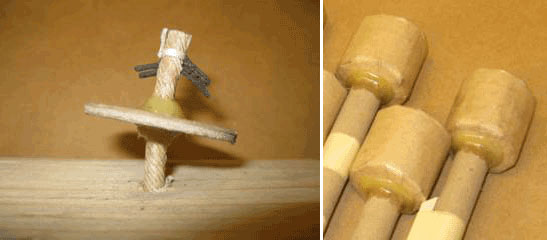
Time-Fuse Sealed into a Cardboard Disc, and Rocket Headings
Attached to Motors with Hot-Glue
Some hot-glue safety considerations are no-brainers. It's only common sense that the metal tip of a hot-glue gun is going to be very hot--hot enough to melt the hot-glue to a free-flowing temperature. So, coming into intimate personal contact with that end of the gun is going to be a "bad thing."
Hot-glue pumped out of the end of the gun is going to be, well, hot--and sticky. Makes sense. You get that hot hot-glue on you, and it will stick to you, and burn you. Another bit of common sense.
Hot-glue-gun parts, particularly the nozzle, may reach temperatures of 380 °F (193 °C) or more. While this is comfortably below the temperature required for ignition of most pyrotechnic compositions, it never hurts to be extra careful, particularly when working with new, potentially sensitive, or uncommon comps. It is well worth the sacrifice of one of those unobtanium stars to a careful test in a safe place to be sure your hot-glue gun or glue isn't going to set it off inadvertently.
But, there is another problem associated with hot-glue guns which might not be so apparent at first blush. In the pyro community, several times a year, we hear of a hot-glue gun which starts "snapping and popping," smoking, and shooting sparks out its sides.
If this were to happen while we were gluing pages on a display board for our kid's science project, it might scare us, and it might singe the carpet before we were able to unplug the gun. But that is as serious as the situation would probably get unless the gun was left plugged in and unattended.
However, if this shorting-out and sparking happens while we are working with live pyrotechnic materials it might ruin our whole day--or our whole life. This sort of incident is no laughing matter when it involves fireworking.
Due to this hazard, some fireworkers have sworn off the use of hot-glue guns in their personal work practices. The devices they make, and the methods they use, can be tailored to the use of more conventional glues and techniques.
But, some of us have become rather dependent on the use of hot-glue in our fireworking. We make one-off devices, quickly going from one step to the next, and having to wait overnight for glue to dry would really cramp our style.
Fortunately, there are some simple-to-apply safety practices for the use of hot-glue guns in the pyro workshop which will greatly mitigate the potential dangers. The adoption of these practices, and getting into the habit of rigorously applying them, can practically eliminate the dangers of a major incident associated with glue gun use.
Hot-Glue-Gun Safety Practices
I've come up with some "Hot-Glue-Gun Safety Commandments," which make me feel a lot more comfortable using hot-glue guns in my fireworking.This is my personal, evolving list of hot-glue safety guidelines. I'm liable to add more to the list over the years. This list of mine should not prevent you from looking around your shop, at your own practices and equipment, and asking yourself, "What else can I change to make this process and environment safer?"
| 1) |
Buy quality glue guns The bargain-department-stores and dollar stores sell very cheap, little hot-glue guns in their crafts department. These guns can be fine for around-the-house projects. They are not of a quality and reliability which is suitable for our fireworking needs, though. Amazon.com and Home Depot sell these Arrow hot-glue guns, and packages of 10" all-purpose glue sticks which work well in them. I've had several of these guns. They hold up well, and they are not expensive, costing less than $20. 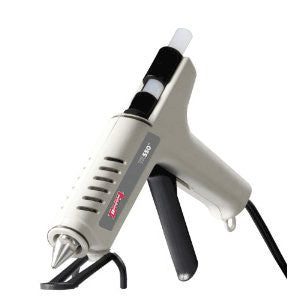 Arrow Hot-Glue Gun Pyrosupplies.com sells a nice selection of hot-glue guns and glue. I personally use an 80 watt Pro 4000A gun, and the fast-setting package-sealing glue sticks. That gun has all the power I need, it cost less than $40, and it has held up well. The fast-setting glue sticks do not create a lot of "strings" when they are used, which minimizes mess and potential problems. One thing I really like about this gun, as compared with the Arrow gun, is that the black gun body has no vent-holes in it. This sealed body would pretty well contain any sparks which were generated within it. 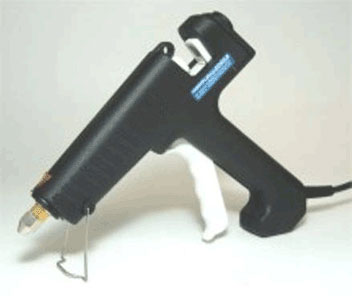 80-Watt Hot-Glue Gun from Pyrosupplies.com The round extension nozzle (0.125-inch orifice), also from Pyrosupplies.com, has been a good investment at less than 5 bucks for getting hot-glue into tight spots: 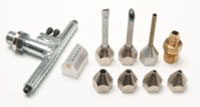 Assorted Hot-Glue-Gun Nozzles Some pyros swear by the "3M Scotch-Weld AE II" gun from Amazon and elsewhere, which runs about $50: 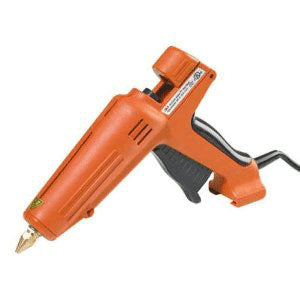 3M Scotch-Weld AE II Hot-Glue Gun Any of these quality glue guns could serve well in a pyro workshop. There are also glue guns which plug-into and unplug from a "docking station," which is in turn attached to the wall outlet via a cord. An advantage of this arrangement is that when unplugged from the docking station for use, the gun has no power going to it. However the docking station in this case should be kept well away from pyrotechnic materials due to the possibility of sparking when docking and undocking the gun. There are also battery operated glue guns for operations in areas where house current is unavailable. |
| 2) |
Store the hot-glue gun upright when it is hot, rather than lying in a pool of hot-glue It's easy to get lazy while using a hot-glue gun, and just keep laying the gun flat on the workbench between glue applications. The gun will then get all covered with excess glue, inside and out, and will end up looking like this: 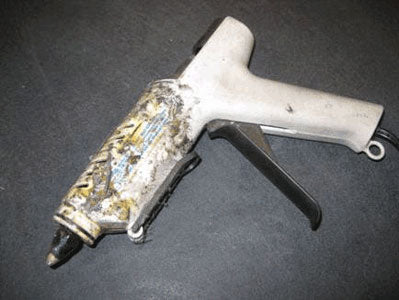 Cruddy Hot-Glue-Gun Reportedly, some of the hot-glue-gun malfunctions have resulted from excess hot-glue fouling the inside of the gun causing the wires in there to short out when the trigger-feed was operated. A clean glue gun is a happy glue gun. 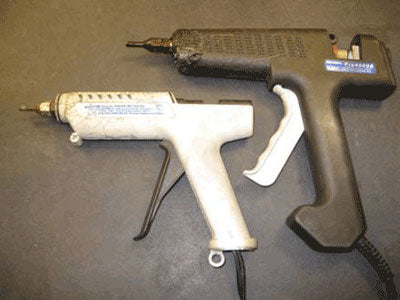 Hot-Glue-Guns Still Clean after Much Service |
| 3) |
Store the glue gun in a "garage" when it is in use This great idea came from Lloyd Sponenburgh. An empty one-gallon rectangular can is easy to turn into a glue-gun garage. 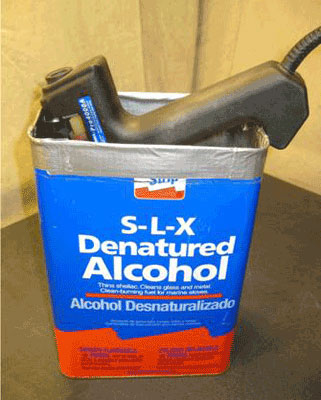 Metal-Can Hot-Glue-Gun "Garage" The lid of a rectangular one-gallon can is removed with a can-opener and pliers. It's darn easy to get cut with the lid as this is being done, so wear gloves and be careful while performing this operation. The sharp edges of the can's opening are hammered flat, and covered with a layer of duct tape to prevent injuries to the gun's cord and the operator's hand. This garage automatically stores the gun upright to keep the gun clean. Most importantly, if the wiring or electronics inside the gun were to short out, the sparks and heat would be reasonably well contained by the garage. To illustrate this, in the photos of the two guns above, you can see that the white gun has slots in its body, which would allow sparks to escape from inside it. The black gun has a more enclosed body which would contain sparks better. This following photo shows that the wiring inside a gun is enclosed in its handle, and the main power cord transitions to smaller interior power wires which lead to the heating element. 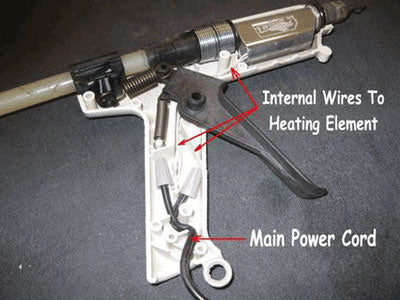 Interior Wiring of a Hot-Glue Gun The handle encloses the wiring well until the wires are routed around the trigger assembly, and up to the heating element. It is in these areas where a potential short could shoot sparks out of the openings in this gun's body. The garage shields these areas, and would contain sparks should they be projected from those parts of the gun. It is obvious that if excess glue is allowed to accumulate around the trigger assembly, or inside the glue-stick advancement area, that glue could pull on the thin wiring and break it or short it out. Hanging the gun upright in the garage keeps it clean and prevents these problems from developing. The black gun (above) hangs nicely on the edge of the garage by that "hook" at the base of its handle. This prevents the tip of the gun from being in contact with the bottom of the garage, thereby preventing the tip from accumulating excess glue. It also ensures that the tip is not cooled by contact with the metal can bottom. In order to similarly hang the white (Arrow) gun from the edge of the can, a band at the base of the handle, made up from narrow wraps of strapping tape, serves well. 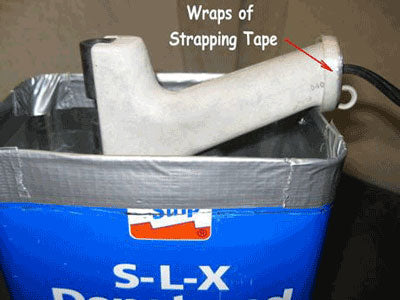 Hanging-Modification of Glue-Gun Handle |
| 4) |
Plug the glue gun into a switched, dust-protected power strip.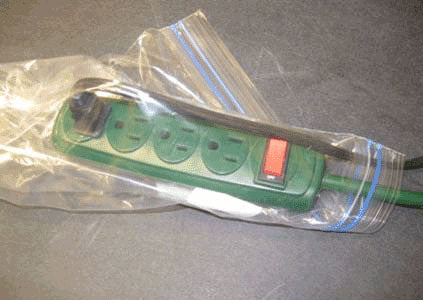 Glue-Gun Plugged into a Switched, Dust-Protected Power Strip The power strip allows me to control the power to the glue gun at will. The plastic-bag protection prevents pyrotechnic dust from accumulating on and in the power strip's outlets and switch, and keeps my composition-covered hands from contaminating the power strip when I operate the switch through the plastic bag. |
| 5) |
Switch the glue-gun off at the power strip before removing it from the garage. That way, when I have the gun out of the garage and am using it, if something happens that causes a gun malfunction, there will be no power going to it, and no sparks can emit from it. The gun and reservoir of already-melted glue will retain sufficient heat to complete most gluing operations before the gun needs to be turned on again. |
| 6) |
Only turn the power back on to the glue-gun after it has been placed back into the garage. |
| 7) |
Keep the garage located to the side of the work area, and absolutely minimize any exposed pyrotechnic compositions anywhere near the garage. The only direction that any sparks could escape the garage would be "up". If I only have the currently-in-use compositions on the workbench, kept to a bare minimum, in a container that is kept closed as much as possible, and away from the garage, I can greatly reduce the likelihood that any major incident will occur. |
| 8) |
When done using the gun, and before leaving the workshop, make sure the switch on the power strip is turned off and unplug the power strip from the wall outlet. This is an important commandment. For obvious reasons, I don't want the glue gun left on and hot for extended periods of time when I'm not in the shop. I've made a habit of looking around the shop as I'm getting ready to walk out the door, and asking myself, "Is there anything I need to do, such as unplugging the hot-glue gun, before I walk out of this shop?" |
| 9) |
Regularly inspect the glue-gun and its cord for signs of wear and tear. |
| 10) | Replace the glue-gun promptly when it starts to look "worn" or starts to seem "old." |
This video shows these simple safety measures put into practice in the workshop:
Using a Hot-Glue-Gun Safely in the Pyro Workshop
